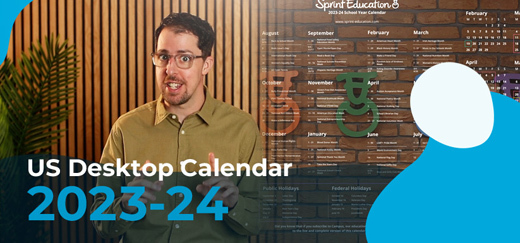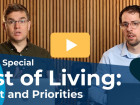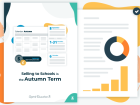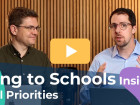Selling to Schools in the Autumn Term 2023
Selling to Schools in the Autumn Term 2023
Gain a sales edge for September with our exclusive school insights for the new academic year.
Gain a sales edge for September with our exclusive school insights for the new academic year.
The summer holidays are upon us, but as usual, they will pass by in a flash!
While teachers and students are enjoying a well-earned break, the summer months offer little downtime for those edu-marketers across the country who want to make their next big campaign stand out as inboxes start to fill in September.
September is the biggest month in the entire school calendar for selling to schools. As part of our most extensive schools survey ever, educators told us they make their biggest purchasing decisions in September.
So, are you ready to start this September with a standout strategy set to make this academic year your most successful yet?
Read on to find out all you need to know about selling to schools in the autumn term.
Key dates to consider during the autumn term
The autumn term ushers in the start of the new academic year. Starting in early September, the term is punctuated by the autumn half-term break in October, and finishes a week or so before Christmas.
September
The autumn term is an incredibly busy period for schools as all pupils and students begin a new year of learning, with new teachers to meet and new routines to establish. For some pupils, the new school year also means a brand-new school. Everyone involved in education will have new names and faces to learn, and new relationships to build.
Primary school teachers will be welcoming and settling brand-new pupils into their classes. They’ll also start the year by running the Reception Baseline Assessment (RBA) – a one-to-one exercise done in 20 minutes with a teacher in an informal setting, and taken by all children in their first six weeks of primary school. For 2023-24 students will complete the assessment using practical resources but from 2024 the tests will involve a digital element completed on a touch-screen device.
Harvest Festivals take place in primary schools in September and October. Pupils are encouraged to donate food to worthy causes, often in celebrations packed with songs, readings, and colourful artwork.
Many older students will be studying subjects for the very first time. Students that have moved up from Key Stage 3 will be starting their new GCSE or equivalent courses. Sixth form and college students will also be starting their A-Level courses, and deciding if they’ve made the right choices.
Parents’ evenings also usually happen in October. Schools must hold at least one parents’ evening a year, with most schools holding two. The first in the autumn allows parents to meet their child’s teacher or teachers, and learn how they are settling into their classes.
Autumn half term
For most schools in England and Wales, the autumn half term tends to fall in the last week of October.
Schools in Scotland usually have half term a week earlier than schools in England. Dates can vary, because school employers are required to set the term dates of their school year. The local authority sets term dates for their schools, whereas academies, foundation schools, voluntary-aided schools, and independent schools are responsible for setting term dates for themselves.
The run-up to Christmas
Time quickly slips by in November, as schools begin to prepare for the Christmas holidays.
Both Primary and Secondary Schools will be planning Christmas fetes, concerts, nativity plays, and carol services before breaking up for the festive season.
There’s plenty to keep track of in the education calendar between September and December, so here’s a small selection of the dates that many schools will be aware of this autumn term:
International Literacy Day 8 September International Literacy Day is an annual awareness day which marks the importance of literacy to all countries and cultures.
The Men’s Rugby Union World Cup 8 September - 28 October The 2023 World Cup in France begins on 8 September, as 20 teams aim to reach the final and become world champions on 28 October.
Black History Month 1 – 31 October Black History Month takes place in October every year in the UK and is an annual commemoration of the history, achievements and contributions of Black people.
The Big Draw Festival 1 - 31 October The Big Draw is a pioneering visual literacy charity dedicated to raising the profile of drawing as a tool for wellbeing, thought, creativity, social, and cultural engagement. The charity is the driving force behind The Big Draw Festival – the world’s biggest celebration of drawing.
The National Education Show 2023 6 October The National Education Show is the leading education event in Wales, this year held in Cardiff, providing opportunities and new ways to improve and raise standards, enhance learning experiences, and support learners.
Tomorrow’s Engineers Week 6 - 10 November Tomorrow’s Engineers Week aims to shine a spotlight on engineering, engineering careers, and engineering professionals. From individual engineers to professional engineering institutions, and global engineering companies, it’s an opportunity to showcase modern engineering and inspirational engineers and technicians.
Anti-Bullying Week 13 - 17 November Anti-Bullying Week is aimed at sending a clear and positive message that bullying is neither acceptable nor inevitable in our schools and communities.
Human Rights Day 10 December Human Rights Day marks the United Nations General Assembly’s adoption and proclamation of the Universal Declaration of Human Rights, the first global enunciation of human rights and one of the first major achievements of the new United Nations. 2023 is the 75th anniversary of the declaration.
Key dates on your desktop
View all of the school holiday dates in one place, alongside a selection of major education events in our free downloadable Desktop Calendar for the 2023-24 academic year.
Want to access our full education calendar? Speak to us about Campus. Our Education Insights Calendar, available only to Campus users, is the most detailed education calendar available to sellers for schools, including events, deadlines, exams, awareness days, holidays, and much more. It will take the guesswork out of your school marketing forever!
The shape of school budgets during the autumn term
Maintained schools run their budgets in line with the financial year, from April to March. In contrast, academies run them in line with the school year, between September and August.
Maintained schools will begin forecasting for the new financial year between January and March, while reviewing their current budget to identify any areas for improvement or any underspending. Academies will begin planning for their new budgets in the summer term to make their big purchases in September.
By the time September begins, it’s likely all schools will have any major spending decisions in mind for the year ahead, and they’ll all now have access to their new budgets to put those plans into place.
In addition to their core budget, you should also be aware of other key sources of income, including:
The Sports Premium initiative
In March 2023, the DfE confirmed that PE and sports premium funding will continue for the academic years 2023-24 and 2024-25. The funding is a ring-fenced grant to all primary schools in England to improve the quality of PE, sport, and physical activity. £600 million will be delivered to schools over the two years, with the average school receiving £18,000 for the academic year.
The PE and sport premium is released in two allocations per year, with the first arriving in October or November, and the second in April or May, depending on the type of establishment.
Schools must follow guidelines with their purchases, and publicly report how they’ve used the funding. This funding stream provides a wealth of opportunities for any business offering products and services relating to sports, physical health, swimming, clubs, and more.
Pupil Premium
Similar to the PE and sport premium, the pupil premium provides schools with extra funding on top of their standard budgets. The pupil premium provides schools with the funds to provide extra support for pupils from disadvantaged backgrounds.
In 2023-2024, this breaks down as:
- £335 per service child.
- £1455 per primary school pupil eligible for free school meals.
- £1035 per secondary school pupil eligible for free school meals.
- £2530 per looked-after child.
The pupil premium is paid to the local authority in four quarterly instalments, with an allocation delivered in September to local authorities and in October for academies and free schools.
As per the PE and sport premium, schools must follow certain rules, and document their spending to ensure the money’s being used to support eligible pupils in the best possible way. This can include providing targeted support or professional development for staff or tackling non-academic barriers to success in school, such as attendance, behaviour, and social and emotional issues.
Autumn spending habits
The best place to go to really understand school spending habits is straight to the teachers and school staff that make those all-important spending decisions.
We conducted our most in-depth education survey ever at the start of 2023, capturing insights from nearly 6,000 teachers and school staff to ask key questions about school spending decisions. One of these included: “When are the “biggest” purchasing decisions generally agreed upon within your establishment?”.
The response was conclusive: September is the #1 month of the academic year when schools make their biggest purchasing decisions. This is also the case for contract renewals.
27.6% of schools make their large purchasing decisions right at the start of the new school year in September. Following closely behind are the spring and summer months, with the exception of August, falling in the summer recess. 24.9% of large purchasing decisions were made in June, and 17.2% in July. These results challenge the idea that schools will be winding down ahead of the summer holidays in July, and are more likely to put big purchasing decisions off until September. Looking at these results, it’s worthwhile continuing with your education marketing activity right up until the summer holidays, and nurturing those key relationships where those bigger purchasing decisions are concerned.
It’s worth noting that November came in 10th place, with 5.1% of survey respondents saying they make big purchasing decisions during the month, and December came last, with just 4.3% of schools making such decisions then.
This tells us that while September offers huge opportunities for selling to schools, the window of opportunity through the autumn term is relatively small compared to the summer term.
Our survey also discovered that September is the #1 month of the academic year when schools plan/make decisions on new contracts, annual subscriptions, and cyclical purchases. This is a change from 2022 when September came second. In 2023, June came second with 23.7% of responses, with April a very close third with 23.5%.
The answers are roughly what we would have expected, as the exam season is in full swing in June, giving teachers a bit more time to plan their spending between the start of the financial year in April, and the start of the academic year in September.
Both of these survey answers reinforce what most education businesses likely already know – April, June, and September are the key points of the year to be planning your edu-marketing strategy around.
What does this all mean for your selling-to-schools strategy for the autumn term?
Plan ahead
The autumn term may not officially begin until the first week of September, but it’s no secret that teachers will spend many hours throughout the summer holidays planning and preparing for the return to school. If you want to capitalise on the September rush, leaving your first marketing email until the first week of September might be too late.
You must start building awareness early, particularly if your product or service is a big purchase. Senior leaders will likely need time to secure buy-in from the whole senior leadership team, and possibly the board. This is particularly the case in 2023 during the ongoing cost-of-living crisis.
Ideally, you’ll have started your email strategy in the summer term to build connections, lay the foundations of your offer, and start encouraging schools to consider working with you. By September - when you drop them a quick reminder email - they’ll already know what you offer, they’ll trust your brand, and they’ll be ready to commit.
If you begin a strategy in September, you’ll be battling to be seen in busy inboxes. If a teacher has never heard of you before, they might leave your email unopened in favour of an email from a business that has been contacting them consistently for many months.
If you didn’t begin in the summer term though, don’t despair! You may not instantly win sales in September, but start building a consistent and trustworthy presence in teacher inboxes and you’ll be converting leads in no time.
Avoid the summer holidays
When we say plan ahead, however, we don’t mean bombarding staff throughout the summer holidays.
Staff will be having some much-needed downtime. While they may be in school for the odd day here and there to supervise ongoing projects, they aren’t likely to be holding full-scale meetings to discuss your offer. Do them a favour and keep their inbox relatively clear, and you’ll be much more favourable when you do email them. It’s worth remembering that in secondary schools, exam results land in the latter half of August, so there’s no harm in giving teachers a little well-wishing message to keep you in their minds.
By the very end of the holidays - we’re talking a few days before schools re-open - most teachers will be gearing up for the return to the classroom, and engaging once again with marketing emails. Plus, they won’t be restricted by face-to-face classroom time, so they may find it easier to fit in a quick webinar or a meeting via video conference to discuss your offer.
These few days are a golden opportunity for delivering a high-impact email offering something really useful for a teacher audience, particularly if they can use it immediately in the classroom. Think of free resources, quick guides, or information that will get teachers clicking your call to action.
If you’re further down the sales funnel and you’ve laid those foundations in the summer term, they may be more open to taking up your offer of a demo or discovery call during this period.
Pull out all the stops in September
As mentioned, September calendars and inboxes will be fit to burst. To make your emails stand out, you’ll need to pull out all the stops in those first few weeks of September with impactful, eye-popping emails.
Make sure you know the strategies to help your email land in their inbox at the right time, stand out amongst their other emails, and stay at the front of teachers’ minds long after they’ve closed your email.
While we recommend keeping yourself visible in teachers’ inboxes by delivering a multi-phase email strategy to make teachers aware of your product or service, remember that teachers are busy too. Build a consistent presence, but don’t overwhelm your audience with intrusive sales messages. Offer them value early in your strategy, such as free resources and advice, and save the direct sales messages for those who engage with your outreach emails. Consider throwing in a discount code closer to the end of term to help sweeten the deal.
There we have it. Our top tips for a successful September.
Need more?
If you’re not sure where to start and would like some advice, drop us a line.
We can manage every aspect of your next strategy with our managed strategies plan, and share our secrets about combining email and postal to great effect. Find out more about what we can do for your next email campaign.
Want more control over your campaigns? We’ve revolutionised edu-marketing with Campus - our complete selling-to-schools solution, the emailing platform used by world-class edu-businesses. Learn about why Campus can win you more business with schools.
Get in touch at info@sprint-education.co.uk or 01684 297374
Tags
Email School Teachers
How to Sell to Schools
How to Sell to Teachers
Selling to Schools
Selling to Teachers
Similar Articles


Marketing Courses, Training, and Workshops to Schools
Learn 10 game-changing insights especially for pupil course, training and workshop providers to enhance your education marketing campaigns when emailing schools.
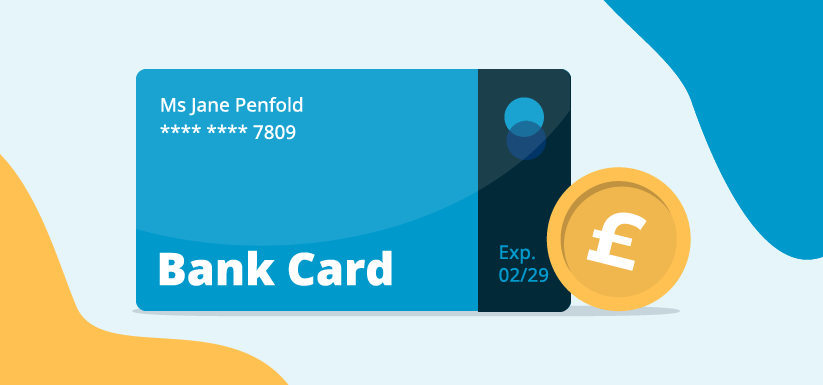

Understanding school funding statistics for 2023-2024’s budget
The government have announced school budget figures for 2023-2024. Get the details, and secure your share of the £57.3 billion.


Expert marketing to K-12 support and solutions
Expert marketing to K-12 solutions
Email Principals, Teachers, and District Staff Inboxes
Email teachers and staff inboxes
Sell More to US and Global Schools and Districts
Sell more to schools and districts















